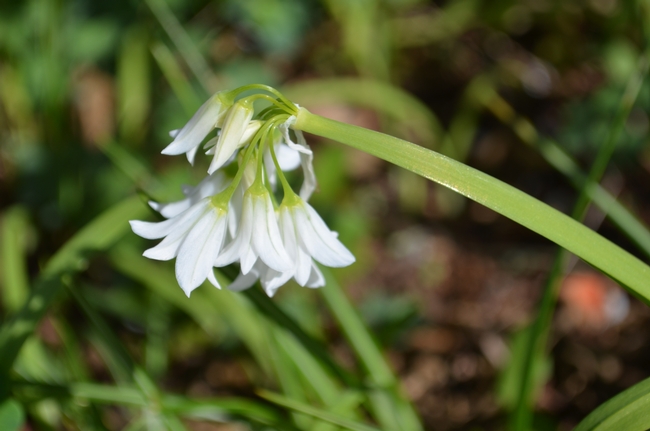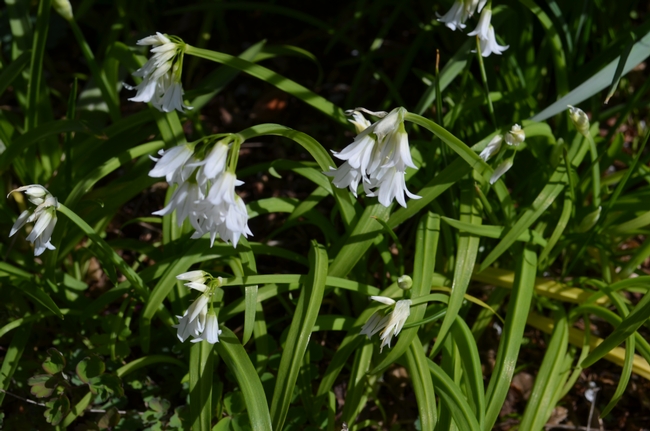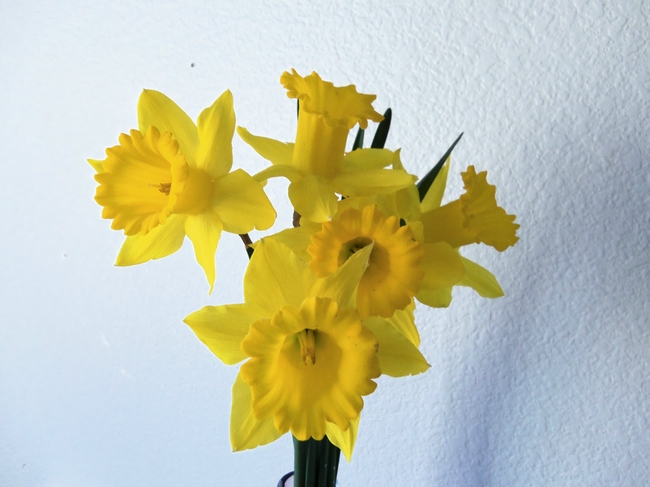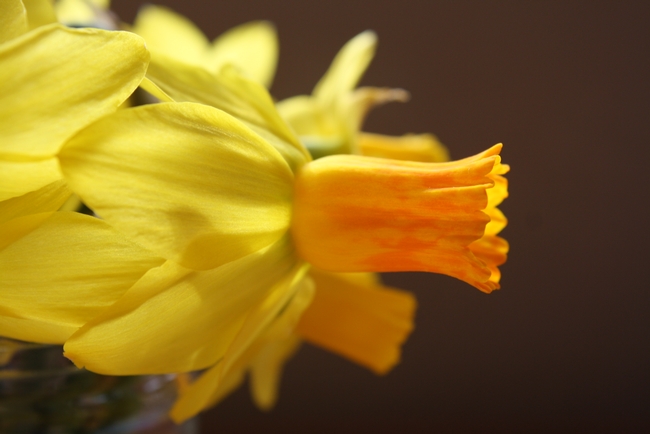Posts Tagged: bulbs
Recipe for Bulb Lasagna
In spring, a cheerful pot of blooming tulips by the front door can snap dreary winter to a close. The bright colors and jaunty stance of springtime’s most famous flowers signal milder days ahead.
Fall is when spring blooms are planted. But why settle for just tulips, when you can also enjoy daffodils, crocus, and grape hyacinths planted in the same pot to produce three waves of bloom, brightening your spring scene for weeks and weeks on end?
The Technique
The technique is called layering or planting lasagna-style. It involves planting layers of different types of bulbs in the same pot, with the various types blooming in secession. By overlapping their bloom times you can create pots of seemingly “perpetual color” featuring double-decker and two-tone color effects.
To enjoy the dramatic display, put layered pots where you’ll see them daily: by doorways, next to the garage or driveway, by the mailbox or lamp post, along walkways or right outside your kitchen window. Spectacular!
The instructions feature crocus, daffodils, grape hyacinths and tulips as the early, mid and late blooming bulbs, but any early-mid-late combo that pleases you will work.
Color & Texture
When selecting bulbs, consider their flower color, as your Lasagna simmers from one planting to the next, having different flower colors adds a sense of “newness” as the waves of color progress. Likewise, there is delightful textural value to each plant, including flowers and leaves. As the bloom progresses, you will be left with leaves from the previous bloom. They may be fine and short like grass or long and strappy, thick and leathery. Having a variety of textures will leave your container with more interest, but also urges you to think, how could I have done this and not hidden my beautiful crocus with leathery leaves.
Planting Bulbs in Layers, Lasagna-style
For three waves of bloom, you’ll need bulbs that bloom in early-spring, mid-spring, and late-spring. Different types of flower bulbs bloom at different times. Bulb packages list this information on the labels. When making bulb selections, consider choosing bulbs with overlapping bloom times so that the planting remains colorful all season. Include grape hyacinths in the mix, for instance as they bloom for weeks on end, providing a colorful cobalt blue under-planting to mid-season daffodils, and continue to bloom in support of the late-season tulips, as well.
Minimize Cold, Wind Exposure
In choosing a pot, the larger the better so as to provide added insulation to the roots. In colder climates, freezing can be an issue so you may need to place your pot(s)in protected areas away from extreme cold and wind (against a house foundation, on a porch, or deck where they receive “radiant heat”, for instance).
Choose Early, Mid, Late Blooming Varieties
Excellent bulb choices for layering would be crocus (early-season), daffodils and grape hyacinths (mid-season), with the same grape hyacinths still there in bloom with the tulips (late season). The cobalt blue grape hyacinths (aka muscari) are the “glue” that hold this particular scheme together, by virtue of their extremely long bloom season.
Positioning the Bulbs
- Pretend you are making lasagna! You’ll plant the largest bulbs approximately 8-inches deep, smaller bulbs 5-inches deep. Potting soil provides the layer (the sauce) under and over your bulbs.
- The Sauce (potting soil) is now added, about 2”-3” deep, so when you measure from the top rim of your pot down, the potting soil level should be about 11 inches below the rim. Sprinkle on a fistful of bonemeal.
- The 1st layer will be a bulb such as a large size (king Alfred) daffodil, allium, or tulip. Place your bulbs in tight so you’ll have quite a color show. Or you can mix them up or in a pattern.
- The Sauce - Add 3” inches of soil above the first layer. Sprinkle on a fistful of bone meal.
- The 2nd Layer will be a bulb that is planted about 6” below the surface such as Dutch Hyacinth or a jonquil narcissus. Leave about ¼” between them.
- Don’t overcrowd, remember these bulbs are fairly well dehydrated and will swell once watering begins!
- The Sauce – Cover with about 1” inch of soil above the previous bulbs. Sprinkle on a fistful of bone meal.
- The 3nd Layer will finish your container off with bulbs like grape hyacinth (muscari) and/or crocus. Remember to leave a little space in between bulbs.
- The Sauce – Top off with five inches of potting soil, add some pansies or other colorful cool weather annuals.
- The Cheese- (mulch) Top dress your creation with mulch, water regularly and wait for the show.
Let the Show Begin
As spring arrives, sit back and watch the show as the waves of colorful flowers come up, bloom and move on.
As each wave blooms, then fades and dies back, that wave’s leaves will remain. Crocus leaves are attractive, slim and grass-like, just let them be. Daffodil /Jonquil leaves are also nice but you may want to snip off the faded flowers and stems to the leaves. Tulips can be the grand finale if you late blooming variety, which is a good thing as fading tulip leaves are unattractive.
Once the last ones fade, it is time to dig up the whole lot and replant everything in the yard or garden in a less-than-primetime location or just put the whole container somewhere out of sight but still being watered until foliage turns brown. Bulbs use their leaves to absorb nutrients which are stored in the bulb itself. If you cut the leaves off too soon, they will not have the energy stores to flower again next year. After all foliage is brown, it’s time for hair cut and decisions for your bulbs future. Daffodils, crocuses and grape hyacinths are bulbs that naturalize well and can be easily planted in the yard where they do not get much water. If you choose a well-drained, sunny spot to replant these bulbs, there’s a good chance they’ll come back in future years to bloom again and even multiply.
Don’t be tempted to leave the bulbs in the same big pot if summer flowers will be planted in it next. Routine watering and fertilizing for summer flowers will damage/rot bulbs. Bulbs originate from areas that have harsh winters and hot waterless summers. Better to plant them into the ground, along a path or in a bed just for bulbs, this way come fall, you can gear up, fertilize them and get them back on the road to bloom again
Fertilization
Both spring and summer bulbs need phosphorous to encourage root development. Keep in mind that phosphorous moves very little once applied to the soil. Some bulbs are planted 6 to 8 inches deep. The phosphorus needs to be mixed in the soil below where the bulbs will be located so it can be utilized by the bulb roots. Mix bone meal with the soil in the lower part of the planting bed as it is being prepared.
If bulbs are going to be maintained in a planting bed more than one year, it is important to supply additional fertilizer bone meal each autumn. Spring flowering bulbs should have mixed into the soil in the fall five tablespoons of 10-10-10 soluble fertilizer (or equivalent bulb fertilizer) plus two cups of bone meal per ten square foot area. With the arrival of new shoots in the spring, repeat the above soluble fertilizer application. Do not fertilize spring flowering bulbs after they have started flowering. This tends to encourage the development of bulb rot and sometimes shortens the life of the flowers.
Summer and fall flowering bulbs should be fertilized monthly from shoot emergence until the plants reach full flower. Apply seven tablespoons of 10-10-10 soluble fertilizer (or equivalent bulb fertilizer) split over two or three applications over a ten square foot area.
For good bud development, work bone meal into the soil at planting and check your soil ph twice a year and adjust as necessary.
This (Wild) Onion Makes Me Cry!
When it recently rained for days in a row, I stood at the window and watched my weeds grow. I have quite the variety of weeds, as I suspect we all do, but some I don’t really mind. For example, Oxalis is extremely invasive, but it is somewhat pretty and is almost enjoyably easy to pull up from the soil. Even if I don’t always get all of the bulbs like I should, at least I can hold some hope that I’m weakening the bulbs by pulling up the rest of the plant. Plus, Oxalis goes dormant with the summer heat. Out of sight, out of mind, right?
But my least favorite? The wild onion, Allium triquetrum, which is also known as the three-cornered leek. It’s not an ugly weed—in fact, it is sometimes cultivated as an ornamental. It has flower stems of about 1 foot tall, with nodding clusters of small, bell-shaped, white flowers. Not surprisingly, it has a strong onion smell.
The wild onion multiplies quickly, spreading by bulbs and seeds, and it is very hard to remove once established. Like Oxalis, it can be controlled by digging up the entire plant, including the bulbs. But unlike Oxalis, which pulls up easily (thus giving me a false, yet satisfying, sense of accomplishment), wild onion snaps at the soil level every time I try to pull it up. So the entire plant must be dug up, which is difficult to do given the extent of its spread throughout the yard, its proximity to other more desirable plants, and the depth to which I must to dig. And I think that’s what I find so aggravating about the wild onion. I could quit work and dig wild onions for the rest of my days, but I’m still fairly sure that I will not prevail. It spreads so quickly and so thoroughly! So at best, I try to content myself with digging a few plants and snapping off the flower stalks so that the plants don’t spread even more via seed. I know there are worse weeds, but this wild onion is the one onion that makes me want to cry.

Close up of wild onion flowers. (photos by Erin Mahaney)

Note the cluster of white onion plants.
Daffodil-March Flower
There are specific flowers which are traditionally given according to the month that a person is born. The March birth flower is the Jonquil (aka Daffodil or Narcissus). Narcissus is the botanical name for all plants known by the names “daffodil,” “narcissus,” and “jonquil.” They are in the Amaryllidacea family. The scientific name of a flower species is formed by the combination of two terms: the genus name and the species descriptor in the case of the Jonquil is Narcissus jonquilla.
The best part about these early blooming bulbs is how easy they are to grow. Since they are native to southern Europe and the Mediterranean countries, they grow well in Solano County. The original daffodil is a bright or golden color and has a trumpet-like corona in the center with petals all around it. Often the trumpet is a contrasting color, and with the advent of hybrids the daffodils themselves can now range in color from white, yellow and orange to pinks and light greens.
Here are some simple guidelines for growing:
Exposure and Soil: choose a planting area that will be in full sun while the bulbs are blooming. This includes under deciduous trees that will allow for full sun. Plant the bulbs in well-draining soil.
Planting: after buying solid heavy bulbs, set them pointed end up in the ground, approximately twice as deep as they are tall. For large bulbs it is usually 5-6 inches deep and 3-5 inches deep for smaller bulbs. In our area, plant bulbs in the mid-fall, right before rains begin. It is important after blooming to let the foliage mature and turn yellow naturally. The foliage is manufacturing food for next season. Bulbs do not need watering in the summer. Also, bulbs do not need to be divided yearly. Established clumps only need dividing when flower production or bloom quality declines.
Cut Flowers: blooms are long lasting but should have a vase of their own. Freshly cut stems release a substance that causes other cut flowers to wilt.
Events: the Northern California Daffodil Society (http://www.daffodil.org) hosts several events for us to enjoy: March 10-11, the Annual Flower Power Daffodil Explosion, Point Arena, Mendocino County; and March 17-18, the Mother Lode Daffodil Show, Ironstone Vineyards, Murphys, Ca.

Yellow daffodil. (photo by Karen Norton)

Narcissus 'Jetfire' has orange trumpet and reflexed petals. (photo by Jennifer Baumbach)
Early Bulbs
One of the most poignant harbingers of spring comes as a delightful surprise to me every year. It’s not exactly as if I forget about those bulbs I planted one long ago November. I just don’t think much about them when they’re not blooming. When they suddenly appear in late winter or early spring, it’s such a joy! The first little crocuses, Crocus vernus, pave the way, with the promise of tulips, Tulipa spp., and other big guys on the horizon.
Even though they may be available in nurseries fairly early in the fall, wait to plant them until average nighttime temperatures have been down around 50 degrees for a couple of weeks. Otherwise they may sprout top growth too soon. It’s a good idea to buy them when they first appear in nurseries or stores where warmer temperatures may dry them out. Take them home and keep them in a cool, dark place until it’s time to plant. Water them thoroughly when planting. After that, normal autumn rainfall should provide enough moisture for bulbs to grow strong roots.
After being buried for months with little thought expended on their existence, their flowers emerge so unexpectedly, so cheerfully, they’re like a gift. They make it so much easier to get through any gloomy days still to come. Many of the bulbs in my garden and in a variety of containers were planted years ago. Without an invitation they do their thing and brighten our days – unexpected but most welcome guests.
After Christmas Sales for Gardeners
I love Christmas with all the trimmings including the greenery. The wreaths, the trees, the Christmas cacti, the poinsettias, the rosemary topiaries, the amaryllis and paper whites, and a host of others that take center stage during this time of year that otherwise blend into the background.
While many might just disregard and discard these once January 2nd rolls around, I just can’t bring myself to do so. Always looking for a bargain, and believing that I CAN grow anything (just disregard those plastic pots in my recycle bin) I eagerly ask for folks discarded poinsettias vowing THIS YEAR I’ll be able to keep it growing until next Christmas season.
Other than pilfering these rejects from my acquaintances and friends, there are bargains to be had at your local grocery, hardware, and big box stores. Many stores, in their rush to clear out the “old”, mark items like rosemary plants and bulb kits down drastically. I’m talking 2 or 3 bucks for plants they were selling for $15 or more up until the 24th!
The rosemary is very hardy. It can be a great scent in the house and great to plant in the yard or container. http://ucanr.org/sites/ucmgnapa/files/81948.pdf.
The Paperwhites and Amaryllis that fill the shelves will bloom just in time for Valentines (so many of these are in red and white too!). http://ucanr.org/sites/ucmgnapa/files/81913.pdf.
Many stores also pull out last year’s garden supplies (pots, tools, etc.) in a hope that they won’t have to inventory and pay taxes on it.
So gardeners delight! There is something to do besides looking longingly through our seed and farm catalogs and hoping for an early spring. Get out and spot a gardener’s After-Christmas Bargain!

